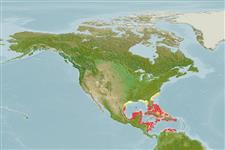Classification / Names
Common names from other countries
Main reference
Size / Weight / Age
Max length : 76.0 cm TL male/unsexed; (Ref. 9710)
Environment
Marine; reef-associated; depth range 1 - 25 m (Ref. 9710)
Climate / Range
Tropical, preferred ?; 36°N - 11°N, 100°W - 66°W (Ref. 55316)
Distribution
Short description
Edge of disk no sharp angles, no dorsal fin. Well-developed caudal fin extends around tip of tail, doubly serrate spine near caudal fin base (Ref. 26938). Disk yellowish, with dark vermiculations and spots that form a variety of patterns on upper surface (Ref. 7251). Lower surface is yellowish, greenish or brownish white, tail with dark spots (Ref.6902).
IUCN Red List Status (Ref. 115185)
Threat to humans
Venomous
Human uses
Aquarium: public aquariums
More information
Age/SizeGrowthLength-weightLength-lengthLength-frequenciesMorphometricsMorphologyLarvaeLarval dynamicsRecruitmentAbundance
ReferencesAquacultureAquaculture profileStrainsGeneticsAllele frequenciesHeritabilityDiseasesProcessingMass conversion
Tools
Special reports
Download XML
Internet sources
Estimates of some properties based on models
Phylogenetic diversity index
PD50 = 0.5156 many relatives (e.g. carps) 0.5 - 2.0 few relatives (e.g. lungfishes)
Trophic Level
3.6 ±0.51 se; Based on food items.
Resilience
Vulnerability
Low to moderate vulnerability (32 of 100)
Price category
